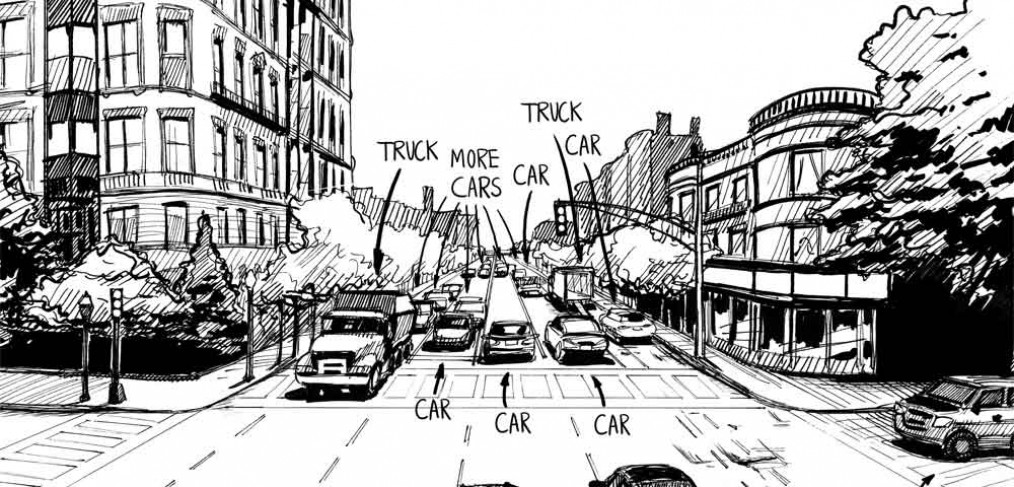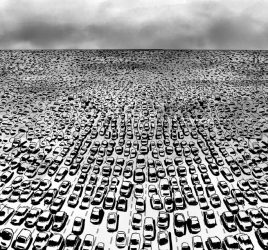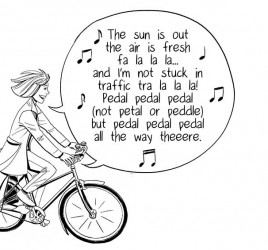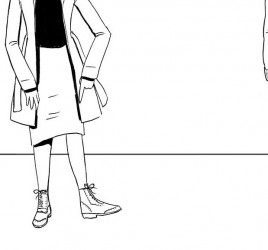
Seeing Things
I was waiting for an appointment the other day when I struck up a conversation with another woman in the lobby. She noticed my bike helmet and the conversation quickly turned to a discussion of cars versus cyclists.
It was just on of those casual conversations you have with a stranger in passing. After voicing the usual complaint about cyclists never stopping for red lights she added that she just “was not looking for cyclists.”
I started thinking about the word “looking.” Do drivers only see what they are looking for? And are they only looking for other cars? Which would mean, to a driver, a city intersection looks like this:
But when I bike through an intersection I am not looking for anything. I am seeing everything. If I were to travel through same intersection at the same moment I might see something like this:
But I probably see every street like this because I have to compensate for what the drivers are not looking for.






It’s difficult for most drivers to process everything going on around them, so they tend to focus only on what they have decided is important: other cars. This is especially true of those people who are holding an iPhone with both hands on top of the steering wheel and only occasionally peering around it while they drive. Your illustrations have summed things up perfectly, very nicely done! And you’ve reminded me of one of the many reasons I prefer riding to driving: I like seeing the world around me. Thank you!
A while back a friend posted a video link that’s an awareness test, it was reallly surprising to me what I missed! 🙂
http://www.break.com/index/awareness-test.html
Yep, that’s called “inattentional blindness” – you tend to filter out what you’re not looking for.
From the Wikipedia page: “Inattentional blindness, also known as perceptual blindness, is when a person fails to notice some stimulus that is in plain sight. This stimulus is usually unexpected but fully visible. This typically happens because humans are overloaded with inputs. It is impossible to pay attention to every single input that is presented. A person’s attention cannot be focused on everything, and therefore, everyone experiences inattentional blindness. People can falsely believe that they do not experience inattentional blindness. This is due to the fact that they are unaware that they are missing things. Inattentional blindness also has an effect on people’s perception. There have been multiple experiments performed that demonstrate this phenomenon.”
This is actually a good argument for integrating with other traffic at intersections. Motorists are not looking for someone traveling 8-20 MPH coming into an intersection from the side of the road, and certainly not on the sidewalk, and especially not the wrong way! You may be afraid motorists will get annoyed at you if take an intersection out in the lane like any other driver, but you are much MUCH more likely to be noticed there.
Commute Orlando just posted a useful article about being seen in intersections: http://commuteorlando.com/wordpress/2012/02/21/vantage-in-the-queue/
Yes, cyclists and pedestrians need to accept that people see what they are looking for. This is strongly influenced by the time they expect to have to react in. This isn’t because drivers don’t care about other people, this is an example of “change blindness”, a universal weakness of humans; nicely illustrated in the video. http://www.youtube.com/watch?v=38XO7ac9eSs
Cyclists need to get off our high horses about this problem of perception. Of course, drivers need to be more aware of this problem. It should be taught in all drivers ed program to drive home the point that public roads are shared spaces with more than cars and truck. Googling on change blindness will take you to lots of dramatic changes. Cyclists and Drivers both need to stop blaming each other and concentrate on their own task at hand.
Don’t see why I (or any other cyclist) should get off my high horse. *We* made a choice that will make our screwups much less dangerous to others. I’d like to see every car driven in a way that makes it as safe for other people as a bicycle is.